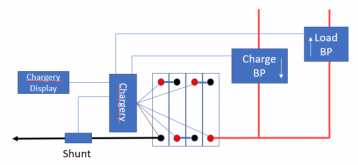You can wire up the overkill and use it's output as a signal.... but it is kinda awkward. When you do this, there is only one 'signal' therefore, if the BMS triggers for a under voltage, your chargers are disabled and manual intervention is required. If the BMS shuts off for overvoltage, the loads are disabled and manual intervention is required.
OK gotcha. This is not necessarily a deal breaker. The application is a liveaboard sailing boat. I'm unlikely to leave her unattended for more than an afternoon, maybe a couple of days at the absolute max. If I'm off the boat, the only loads on the system are the fridge and freezer. So if I come back to warmer beer than I'd like, I can live with that. The freezer should be well enough insulated to be OK for that sort of period.
I'm assuming that if the charging is cut off and needs manual reset, then my cells should still be protected by the LVD on the fridge, as well as the BMS itself. And if I really expect to be away for a period of time, I would probably empty the fridge/freezer and just shut everything off.
I am not sure what you mean by this. Are you talking about using a BMS signal or are you talking about some kind of network control?
I thought it might be possible for the BMS to tell the MPPT to stop charging. This is all based on the idea that the MPPT can be damaged if it's not connected to a battery. I might be overstating that risk, and there might be better ways of mitigating it, e.g. a dump load from the MPPT? To be honest I'm not even sure that an MPPT exists that works like this, the ones I have looked at cannot be commanded by the BMS.
The coil on the contractor is going to take a fair amount of energy to keep closed.
How would you control the contactor?
I was talking about using the BMS to control the contactor. I'm pretty sure the Electrodacus etc can do this? Again this is all about trying to protect the MPPT, as well as the cells. I figured that a latching relay might be suitable.
If you have a signal to control the contactor, then pick an MPPT that can take that signal.
Is this not what I was thinking of earlier, using the BMS to tell the MPPT to shut off. Or did you mean something else?
I personally do not like using external contactors or SSRs to control the current.... They just add complexity. (Note: Using an external SSR is no different than using a FET based BMS.... it is just the FETs are in the SSR) Consequently, if the system is small I will use a FET based BMS. However, as the system get to medium or large it becomes difficult to find a BMS that can handle the current. At that point I go with a chargery or electrocutes and pick equipment that I can control with the signals from the BMS.
What size inverter are we talking about. Anything over about 1400W will be too much for a 120A Overkill.
Yes I guess it's just moving the problem around. Although I would probably trust the FETs in a BP over a Daly.
I have one large load in mind, the inverter. It needs to be 2000w minimum, and I was going to choose a 3000w model to give me a bit of headroom- hopefully not actually using it at full capacity often, if at all. It would mainly be for cooking, and also the vacuum cleaner and the laser printer, all of which would be operated for short periods and obviously never whilst unattended. I'd turn the inverter off when not using these high current devices- I don't need 24/7 access to AC power.
I had originally considered buying a big-ass Daly but once you're drawing 250A loads, and add a bit of margin, it's no longer all that cheap. And I thought the reliability/lifespan might be questionable. It seemed far better to control the inverter in another way, e.g. hack the switch, use a big SSR on the DC side, or smaller SSR on the AC side to shut the loads off.
And at the risk of sounding like a complete newbie (which I am...) just how quickly do you have to react if something is going awry with the battery? Say the inverter was connected with only its own LVD as protection, and I had some very obvious way of knowing that the BMS had tripped. I could shut it off manually in a few seconds. Is this still too slow to save the cells?






